Thanks to everyone for their support and kind words about my premature evacuation from India. It’s only Day Six of my self-imposed quarantine, but it feels more like Day Twenty-Six. Still, I am grateful to have a place as comfortable as 80 square feet can be. At least unlike many, I have a free and secure place to park it, food to eat, internet to entertain me, and a solid 98.6° temperature. So for that, I am extremely grateful!
A good friend of mine who is in the mental health profession suggested we shift the term “social distancing” to instead “engaging in physical distancing but staying socially engaged.” I like that idea. Thanks to all my friends, family, and followers who continue to help me stay socially engaged.
Okay, so now it’s back to a much happier time in Ethiopia when the only things I had to worry about were severe dehydrating diarrhea, pick-pockets, and looking down the barrel of a Kalashnikov held by the roadside militia. Looking back, things seemed so much less scary then.
Traveling along in our loop around Ethiopia, our next stop would be an overnight visit in the village of Arwa Amba. According to our Dragoman trip notes “Awra Amba is a small community made up of less than 500 people. It was founded with a vision of becoming a place where equality was the norm and social values are at the center of life. This vision has succeeded and it now successfully supports a number of families through weaving and farming industries.”
Described by Atlas Obsura as an “egalitarian commune…Arwa Amba’s four tenets underpin the community’s way of life: respecting women’s rights, respecting children’s rights, caring for the elderly and vulnerable, and avoiding antisocial behavior.”
During our usual pre-stop briefing whereby Louise would come back from the cab, sit cross-legged atop the refrigerator, and share “the plan,” we learned about the village, its founder, the visitation schedule, and our accommodation. When at the end, Louise added “I’m not going to say much more….I’ll let you form your own opinions,” I knew it was about to get interesting.
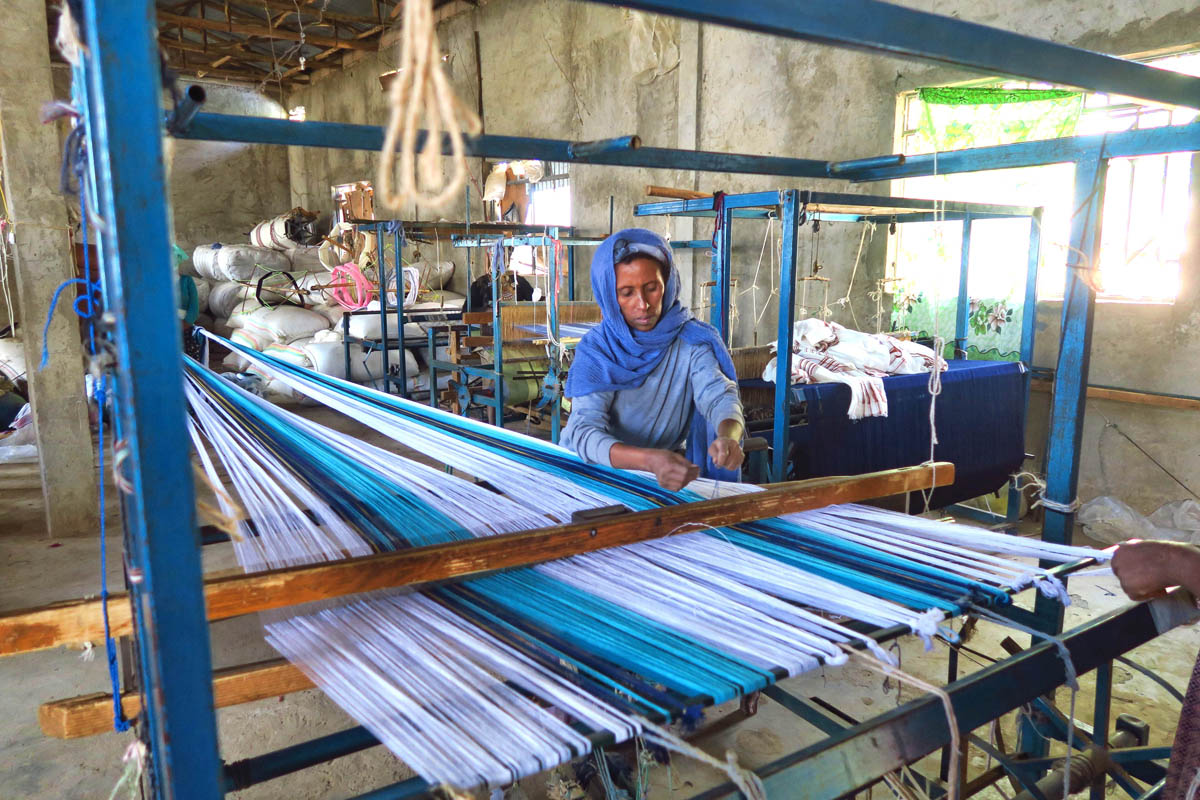
Once Arwa Amba lost a lot of their farmland, they turned to weaving as an industry to support the community.

The woman on the right is our guide, giving us a tour of the community to include the school, library, senior care, and weaving room. Here, she answers Andy’s questions about warp and weft.

The weaving work is shared equally between men and women.
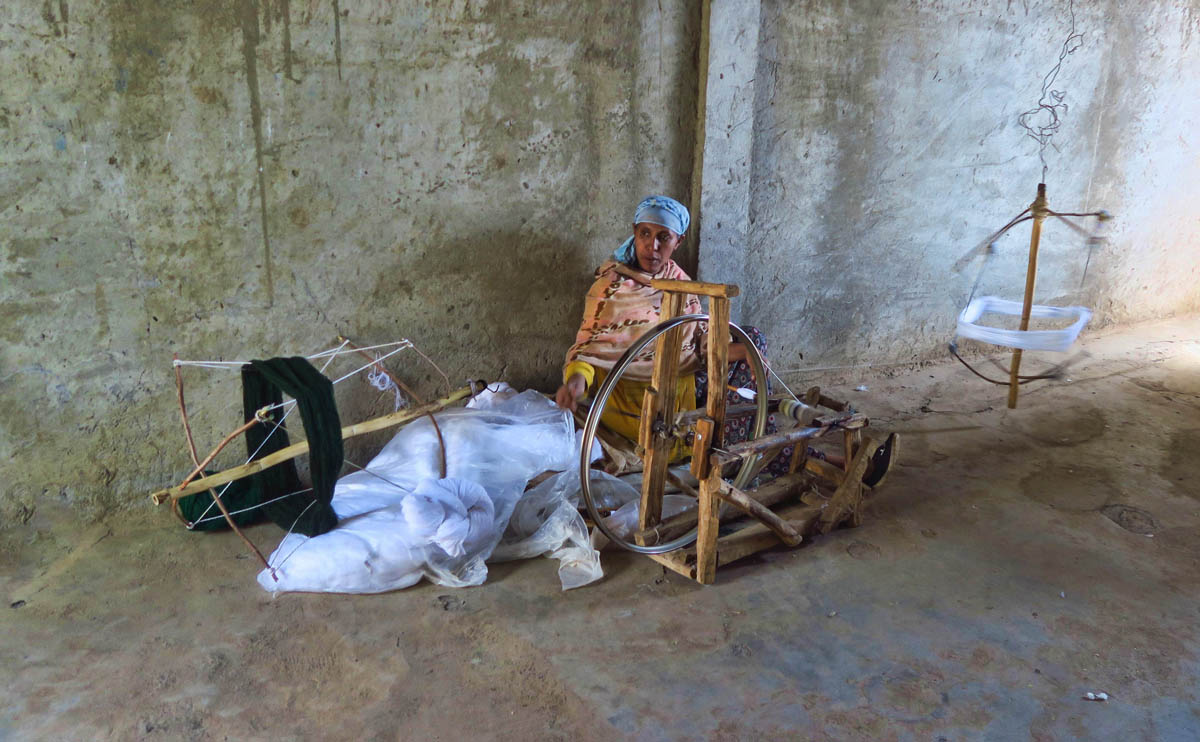
This woman is spinning thread.

You may have noticed in some of the previous photos that women wear traditional clothing to the religious ceremonies. This always involves thin white muslin cloth, trimmed in ornate braid. This man is hand-weaving this trim by threading this long, spear-like “needle” through the warp.
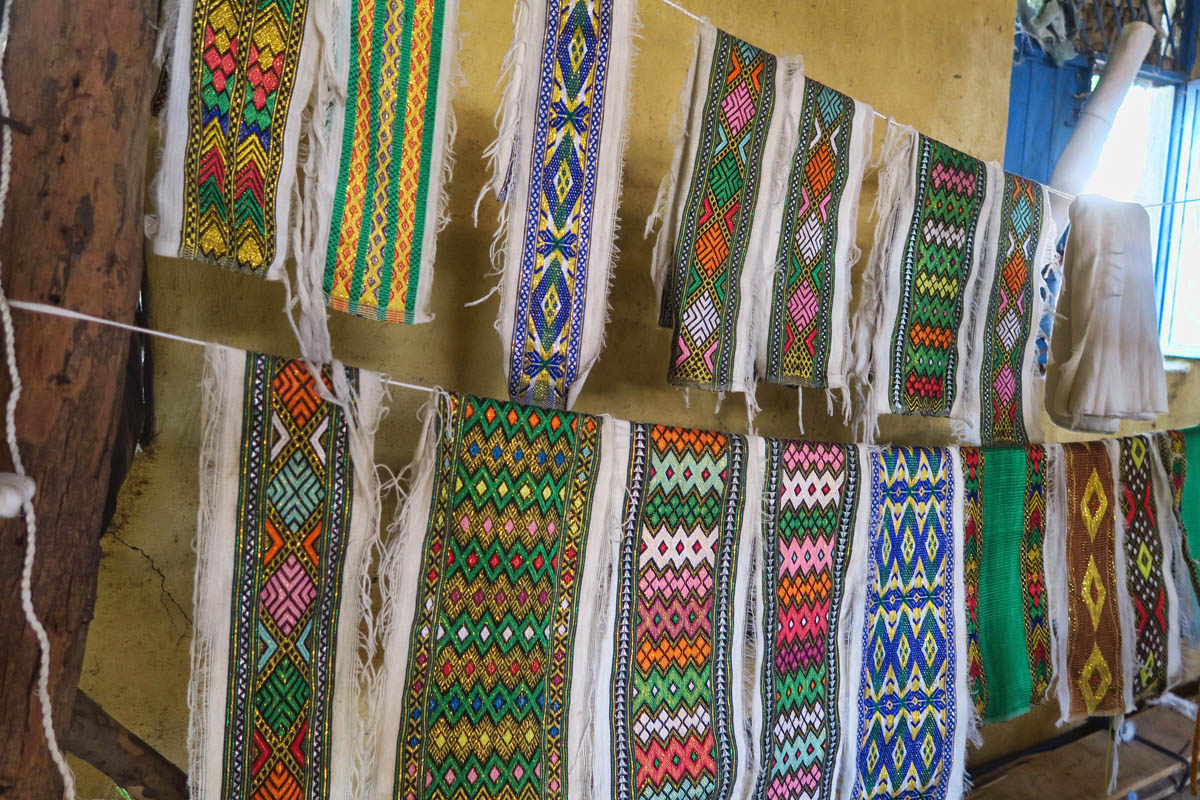
It takes about three days to make a strip of braid long enough to trim a headscarf.
The Arwa Amba community was founded in 1978 by visionary and self-proclaimed child prodigy, Zumra Nuru, who is still alive today. He lives within the community, and sports a bizarre yarn-spiked green hat to remind him of trees. There are two ways to belong to the community. One can either reside there, joining in as a productive member of the community. Or one can be a benefactor and member by proxy.
The beliefs of the community are contrary to almost every aspect of Ethiopian society, from gender equality to a “no begging” policy enforced on the children. But none so contrary as their stance on religion. They believe religion is a personal decision left up to each individual, and there is only one creator for all humankind, a concept contradicted by individual religions. Consequently there are no churches in the community, with the leader maintaining “I couldn’t understand why I should build a house in one particular place where I could go inside to meet the creator if he was to be found everywhere.” Got a point there!
There are also no religious holidays, festivals, or services. They attribute their financial sustainability to the fact that people are working in the fields or their weaving cottage industry daily rather than dressing up in satin gowns and parading around the Ark of the Covenant every other week. On this point, I tend to agree, having witnessed the crowds participating in multi-day festivals since we first arrived in Ethiopia, and wondering “Does anyone ever do any work around here?”
Drugs and alcohol are banned in the community, but that has more to do with “avoiding antisocial behavior” than it does religion.
The societal differences have caused conflict with the neighboring farmers, as they are viewed as a threat to Ethiopian traditions. There have been periods of unrest to the point that they were forced to flee back in 1988 under the authoritarian Derg regimen, as they were turned in as part of the opposition. They returned in 1993 following the end of communist rule, only to find most of their farmland confiscated.
Our stay there involved a fairly decent dinner from one of the community members who is studying the culinary arts. Following dinner, we were treated to a traditional dance beside a bonfire, followed by a fitful night of sleep in small, musty concrete block room on the opposite side of the compound from the communal toilet. Not my best night in Ethiopia, but certainly not my worst either.
The next morning, we were given a tour by one of the female leaders of the community, starting with a question and answer session with the treetop hat-wearing leader himself. Each of us vied for a turn to ask questions which continued for at least an hour. “Are most incoming members born here, or do they join as adults?” (Most are born here.) “Are gay rights included in the tenets?” (No, homosexuality is illegal in Ethiopia.) “Are people free to leave?” (yes) “What happens if they break one of the tenets?” (There is an expulsion process by a Board of Directors, 13 designated leaders of the community, though it is rarely used.) “Are there women on this board of 13?” (long, pregnant pause…)
While I agree with the philosophy of this community on gender equality and individual and personal choice regarding religion, something just felt amiss here. For some reason, my “creepy meter” kept going off. After much reflection, I kept coming back to one word. “Joy.” There did not seem to be any joy here. No smiles from our tour leader. The atmosphere felt very heavy. And while children were in school rather than on the streets begging, they seemed reserved and withdrawn. While they are taught not to beg like the entire population of children in Ethiopia (You! You! You! Pen? Pen? Money? Candy?) they did not have that same exuberance as the other children. Something felt “robotic,” like Stepford Wives without the submissiveness.
I was getting some serious “cult vibes” from this community, and couldn’t wait until our scheduled departure time at 11:00am. I must have checked the clock on my phone ten times that morning. Then Louise, our group leader called us all together and said “We are going to stay a little longer. We’ll be having lunch here. There are protests on the road, the road is blocked, and we can’t get through right now.” This scared the crap out of me, because it sounded like Jonestown all over again. That’s how it begins. People are not allowed to leave when the rescue party lands. Next thing you know, Congresswoman Jackie Speier is lying on the tarmac, shot five times and left for dead as the Koolaid is being passed around! DON’T DRINK THE TEA!!!
Turns out the protests were closer to Bahir Dar, and were students, nothing to do with the community whatsoever. And they peacefully waved us through. But I was still never so glad to be out of there. I am sure it was perfectly fine place, as others on the tour seemed to enjoy it, buying weavings from the shop, and talking to the locals. I guess I just watched one too many Jonestown documentaries.
We continued on to Bahir Dar, our last stop before the capital city of Addis Ababa, final stop on our tour. In Bahia Dar, we would visit Lake Tana, the source of the Blue Nile River, and home to the famous Blue Nile Falls. At 54 miles long and 41 miles wide, Lake Tana is Ethiopia’s largest lake, and holds 50% of the country’s fresh water. From Lake Tana, the Nile River flows almost 3,000 miles through Sudan where it joins the White Nile, and they flow as one through Egypt, into the Mediterranean sea. If you are going to cruise the Nile, 80% of your river comes from here.
The lake is also known for several 16th -18th century monasteries located on islands and peninsulas along the lake. We would visit two of these monasteries, separated by a one mile hike through a coffee plantation. Captions below detail our visit:

Crossing over the Nile Bridge, also known as the “Hippo Bridge.” We are fortunate to spot these guys hovering on the surface.
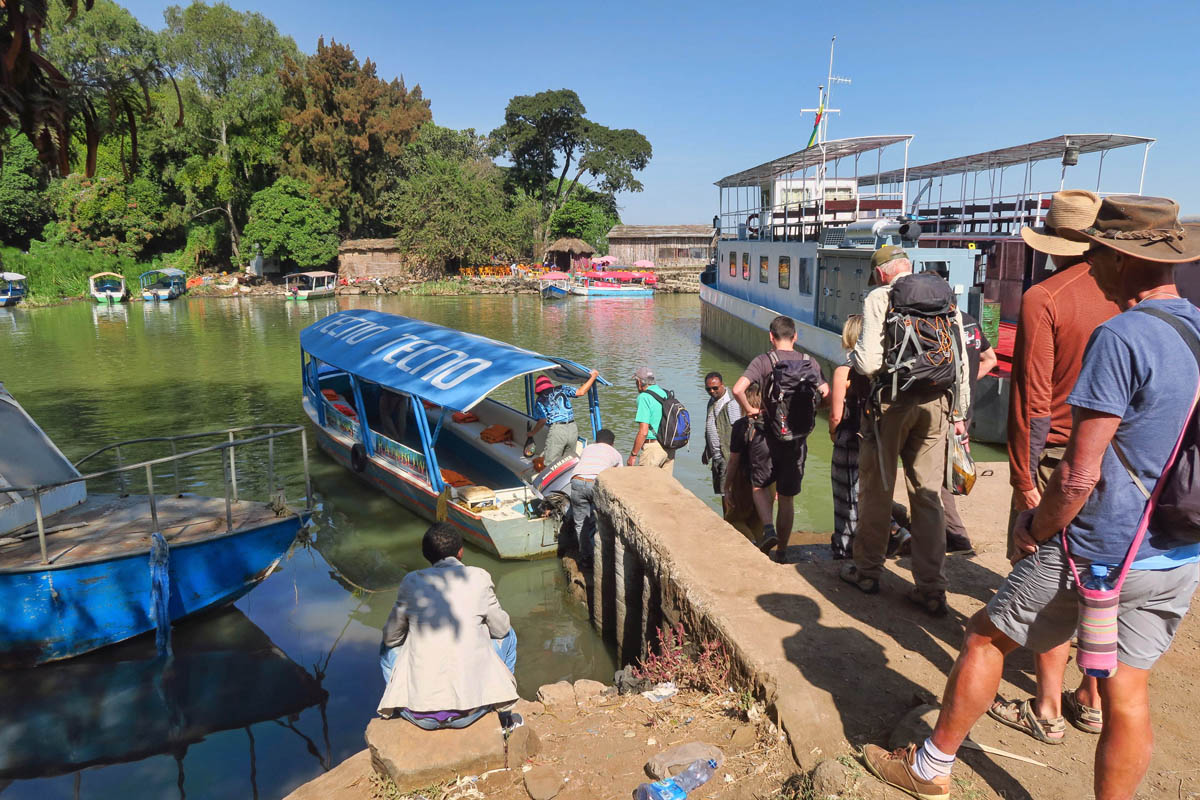
Our group has hired a boat to take us out to tour the monasteries.
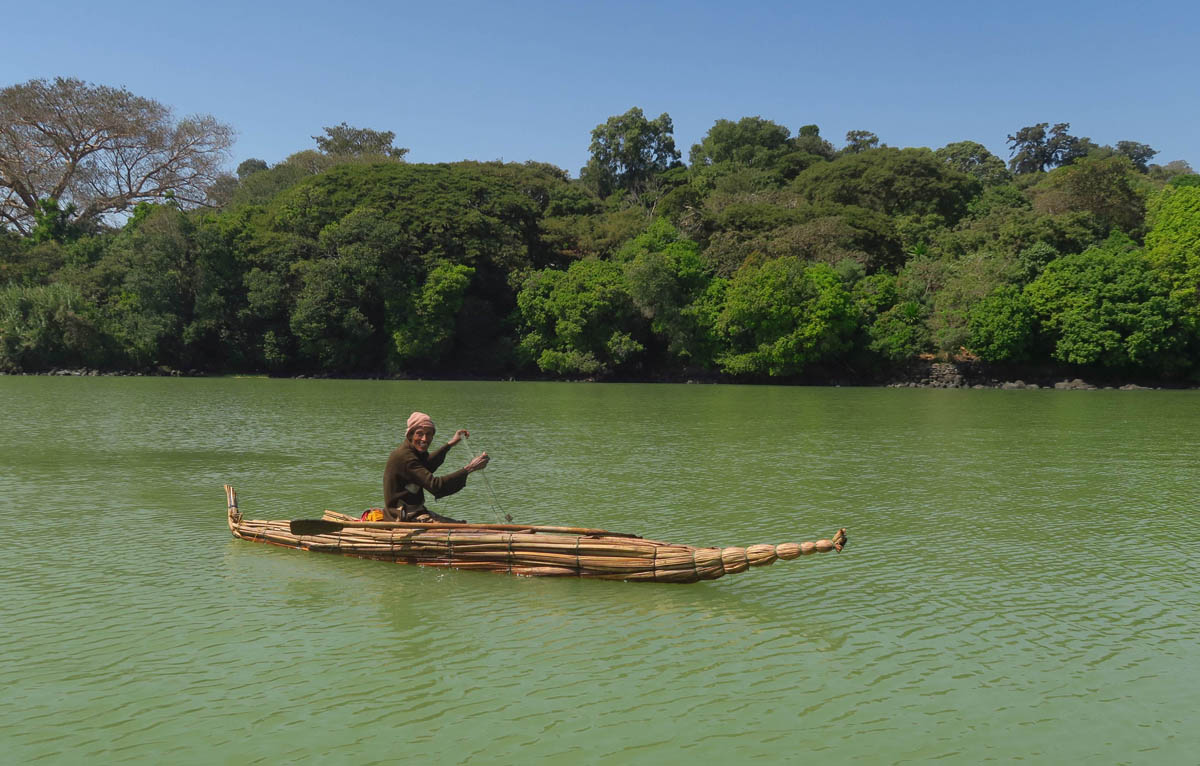
Papyrus canoes called “Tankwas” built from reeds are commonly used by fishermen on the lake.

Ura Kidane Mehret on the Zege Peninsula is believed to have been founded in the 16th century. A circular outer wall encloses the quadrangular “Holy of Holies” decorated from top to bottom with biblical paintings.
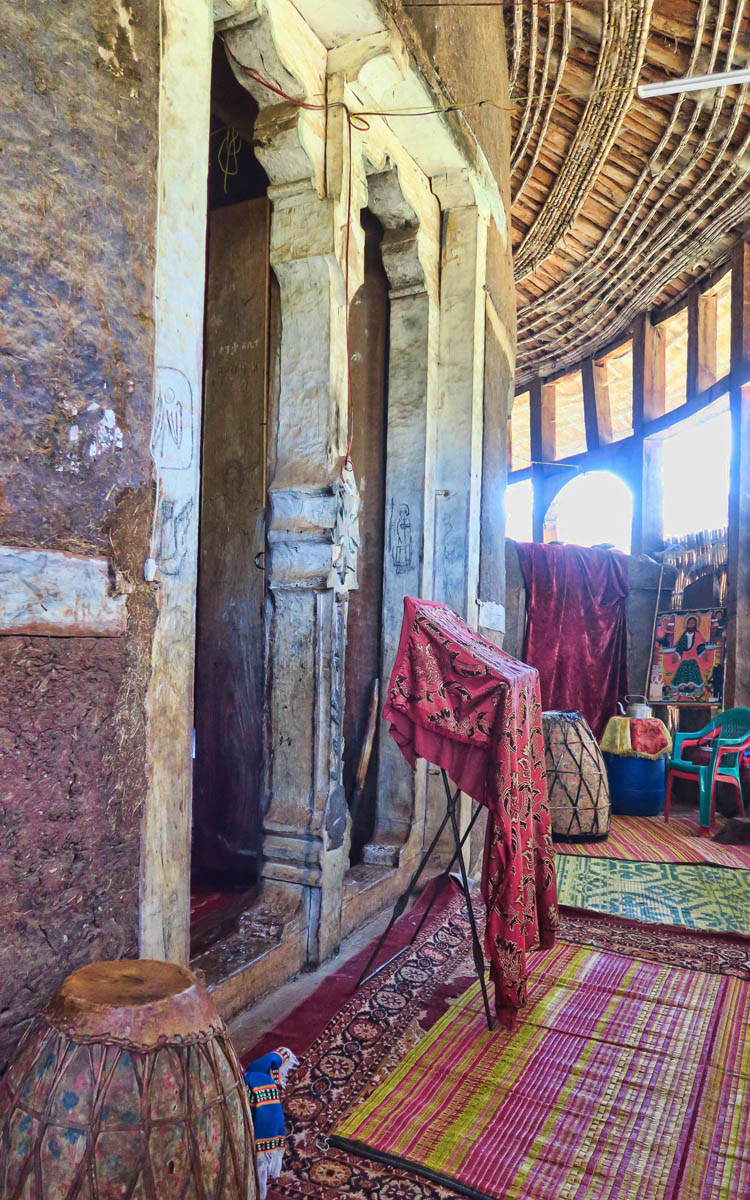
I inquired about the difference between a church and a monastery. Our guide explained that they were both based on Orthodox Christian beliefs, but the churches are for regular services, while the monasteries are more ceremonial.
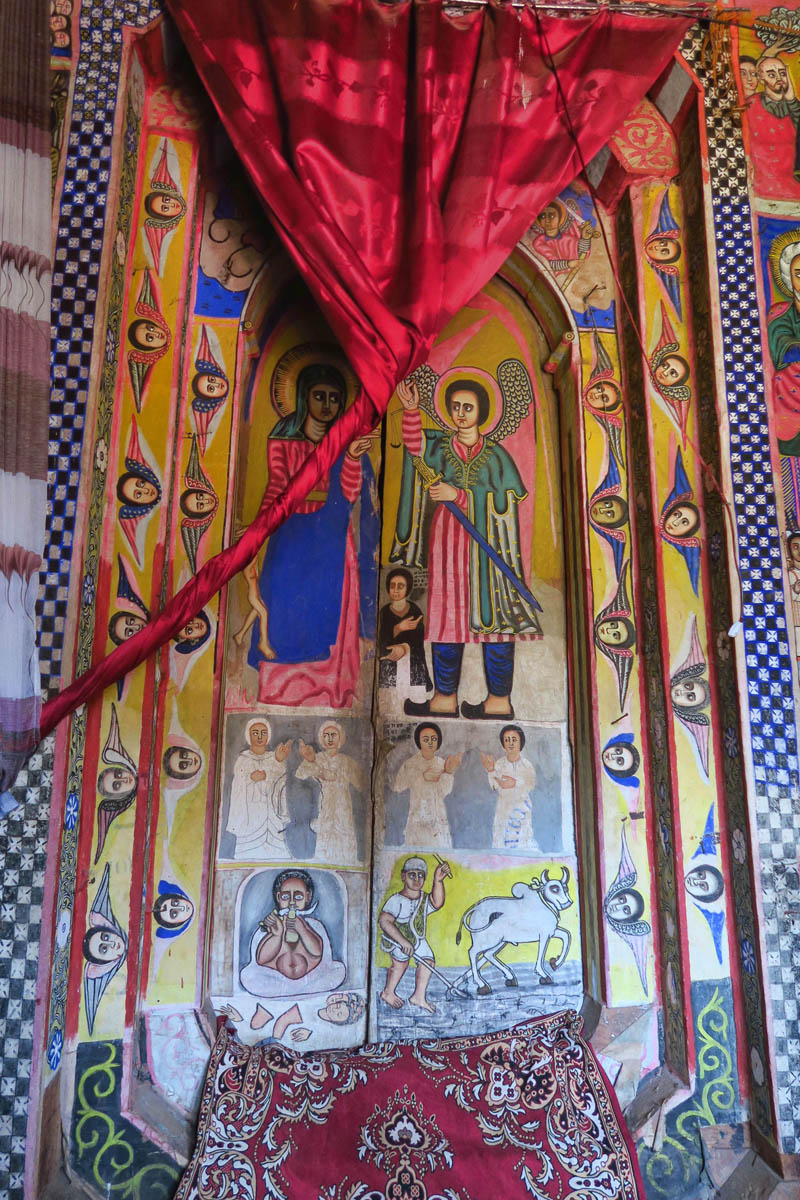
Behind this door is the “Holy of Holies” where only the highest priests are allowed.
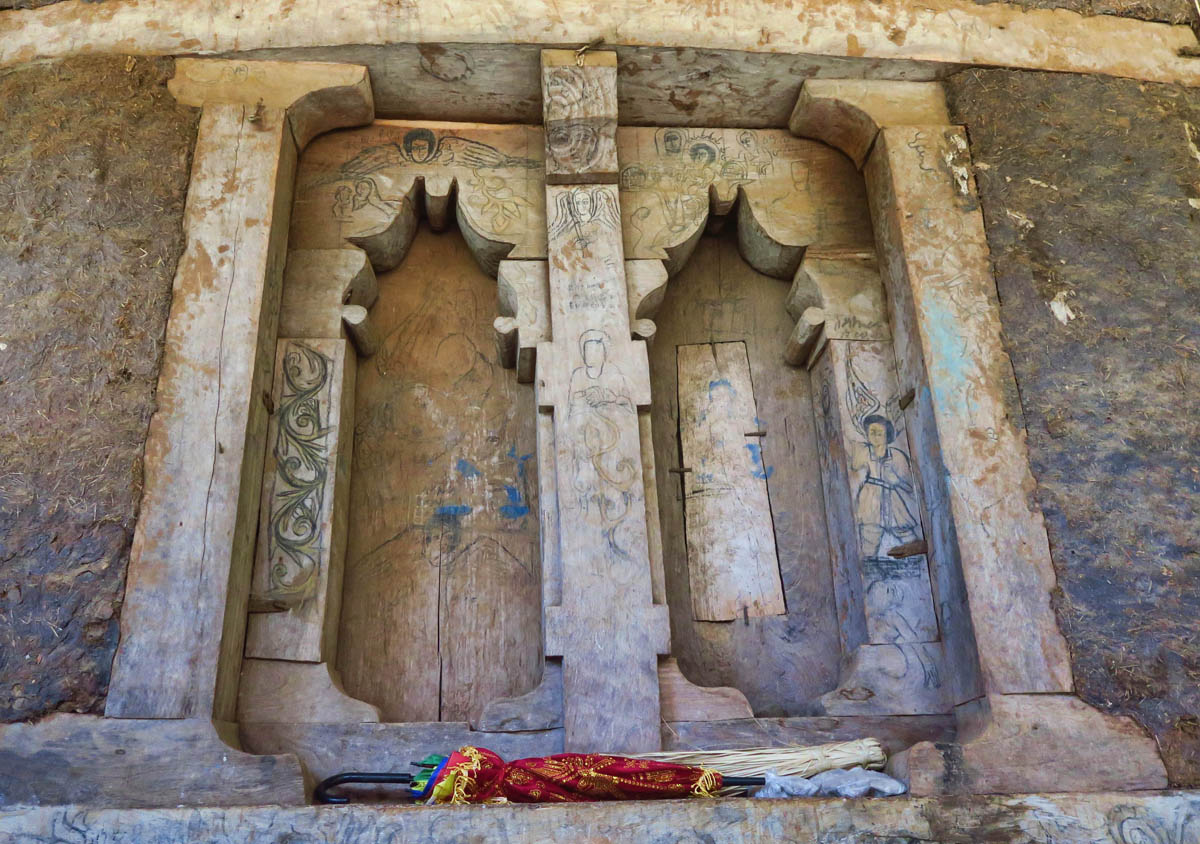
We are visiting two different monasteries on this tour, so we will hike one mile to the second.

Our hike is through a heavily forested area with several coffee plants.
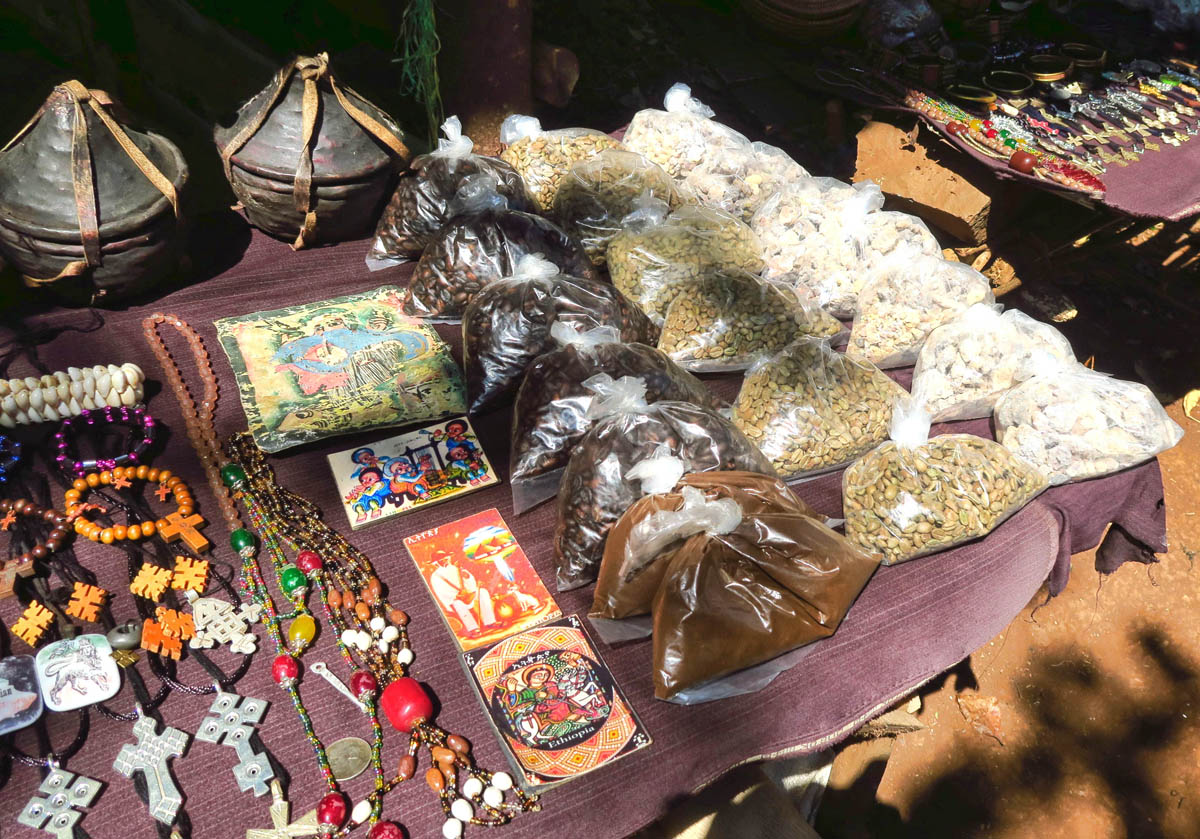
The locals have stands nearby to sell the coffee. The three rows on the right are (L to R) roasted beans and ground coffee, raw beans, and frankincense made from tree sap.
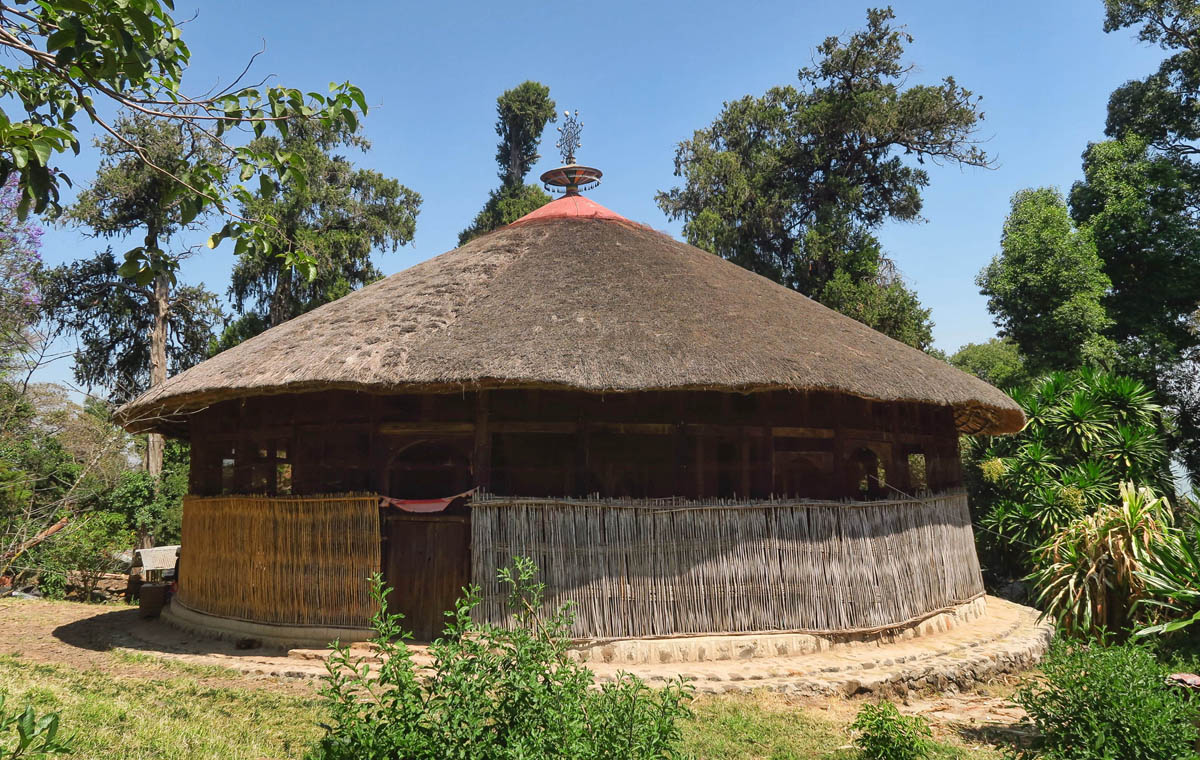
The second monastery we visit is Azwa Maryam, known for its biblical paintings.

We learn that if a certain church or monastery is dedicated to a certain Saint, that Saint’s painting is covered by a sheer curtain.
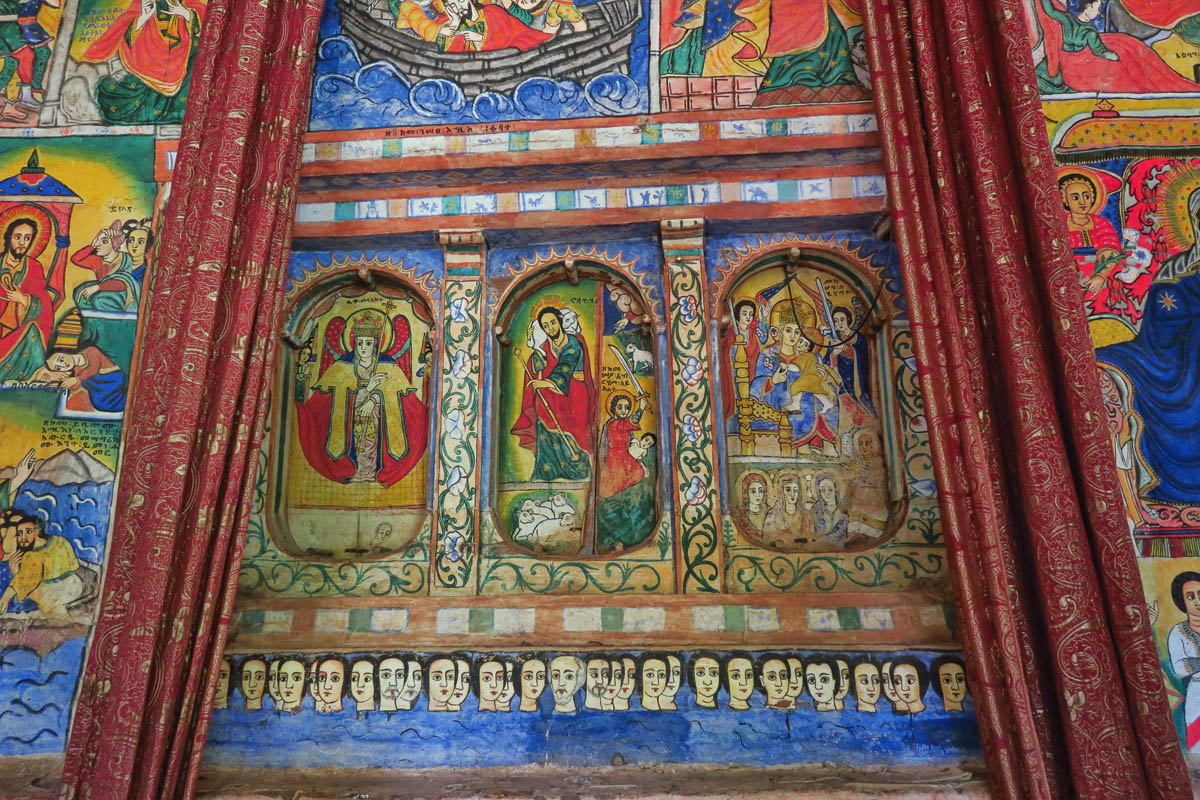
Our guide walks us around all four sides where we must endure an explanation of every painting. Though they are interesting, they eventually all start to look alike.

This one of Judgement Day is pretty scary. The sinner’s side looks cold rather than hot as hell.
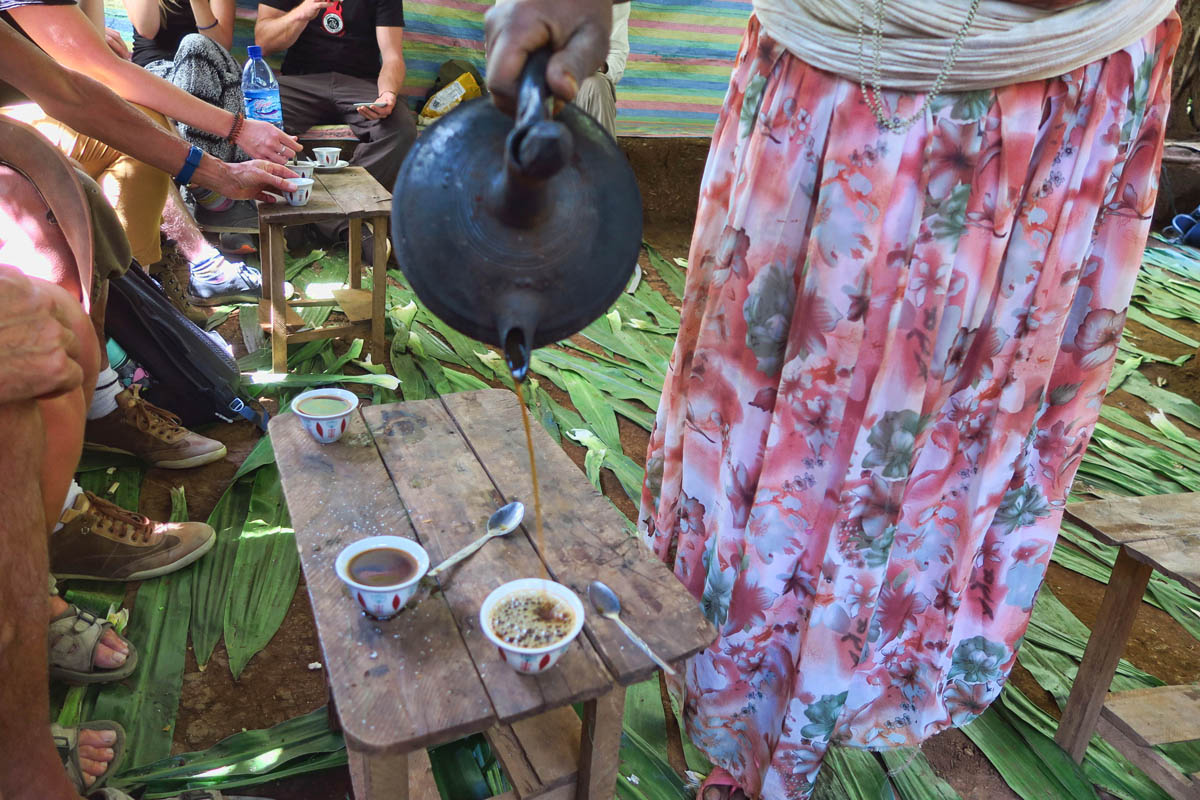
Our endurance and patience during the paintings tour is rewarded with a traditional Ethiopian coffee ceremony. Incense is burned, beans are roasted over open coals, and some seriously strong coffee is poured from a traditional Ethiopian earthen pot.

Ethiopians rarely buy new shoes. Instead they repair, clean, and polish the ones they have. Streets are lined with shoe shiners and repairmen. I am about to get my shoes cleaned by this nice young man for 20 Birr, about sixty cents.

I started out on this trip with a brand new pair of La Sportivas (thanks to the suggestion of my personal shopper.) 😉 I feared they wouldn’t make it through the end of the trip, but sixty cents later, they are good as new!
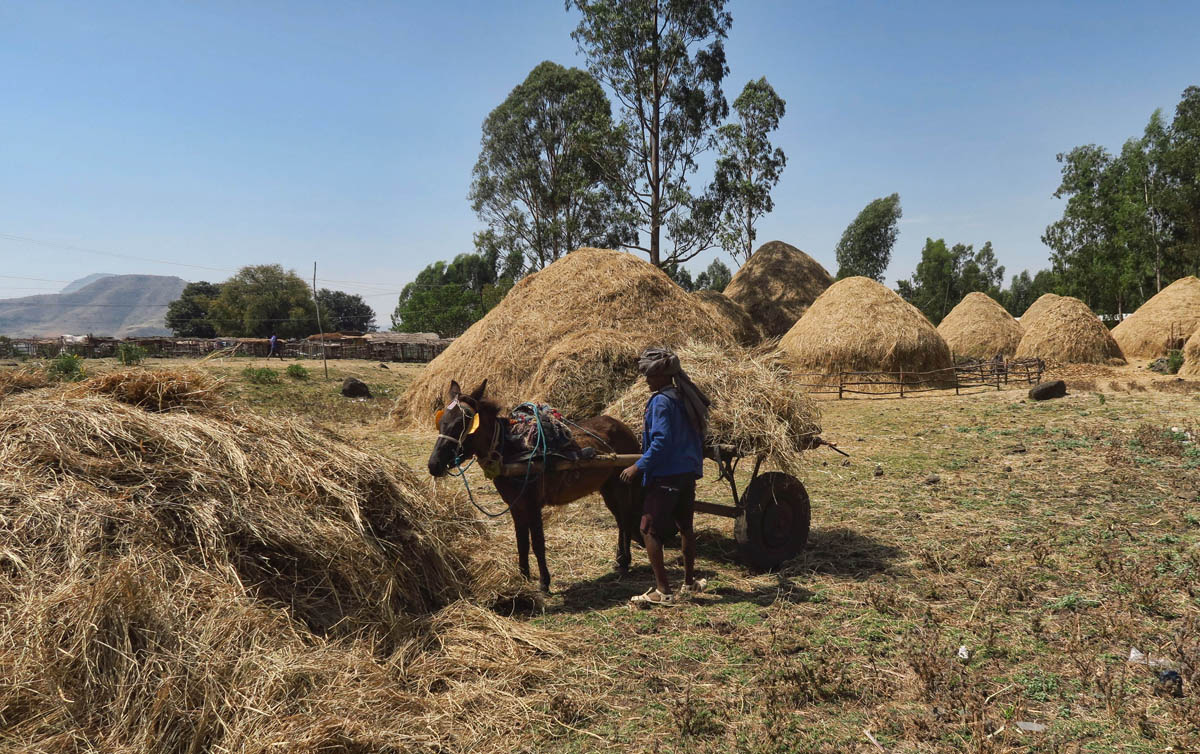
We travel about an hour to Tis Abay, the local village at the start of our hike to the Blue Nile Falls.
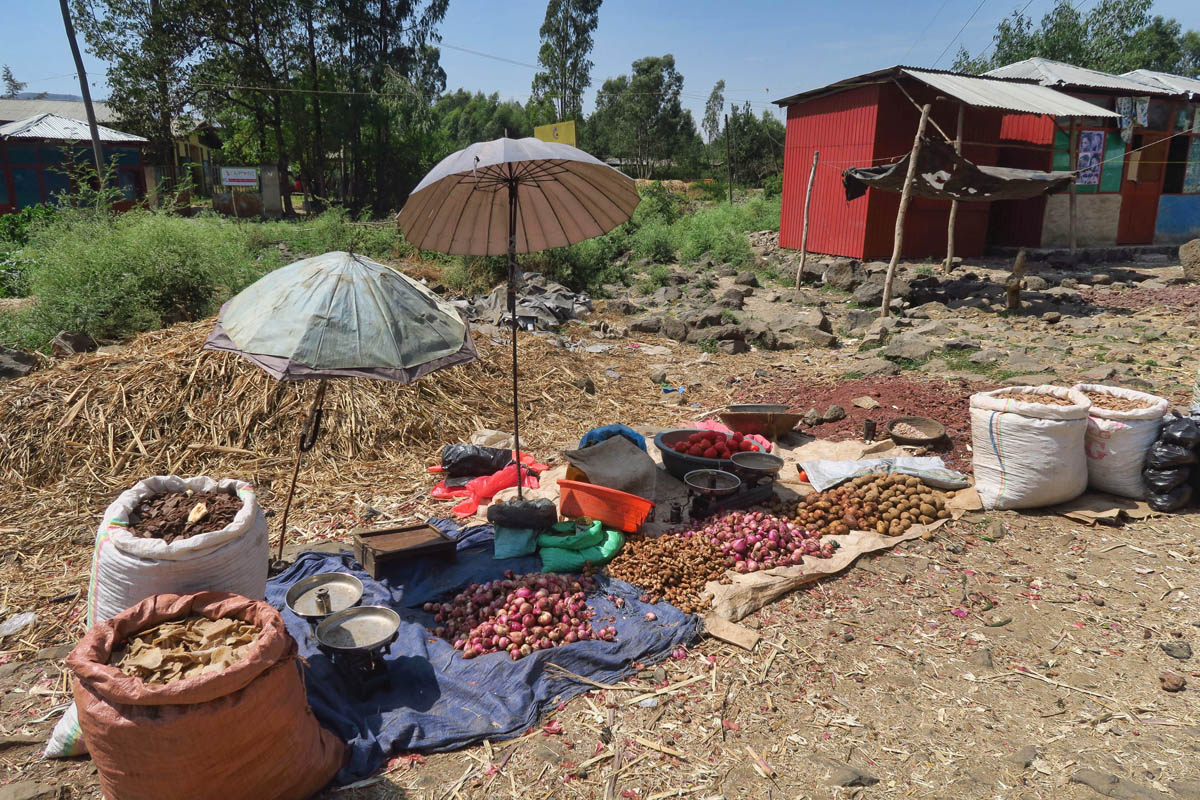
I will never forget “Where were you when?” Some locals here were giving one of our tour members (a Malaysian woman who lives in Sydney, Australia) a bit of a hard time because of her “Asian eyes,” asking if she was from China, and did she have the virus? It was my first indication that news was traveling fast.

Hiking over the Portuguese Bridge built at the turn of the 19th century across the Blue Nile.
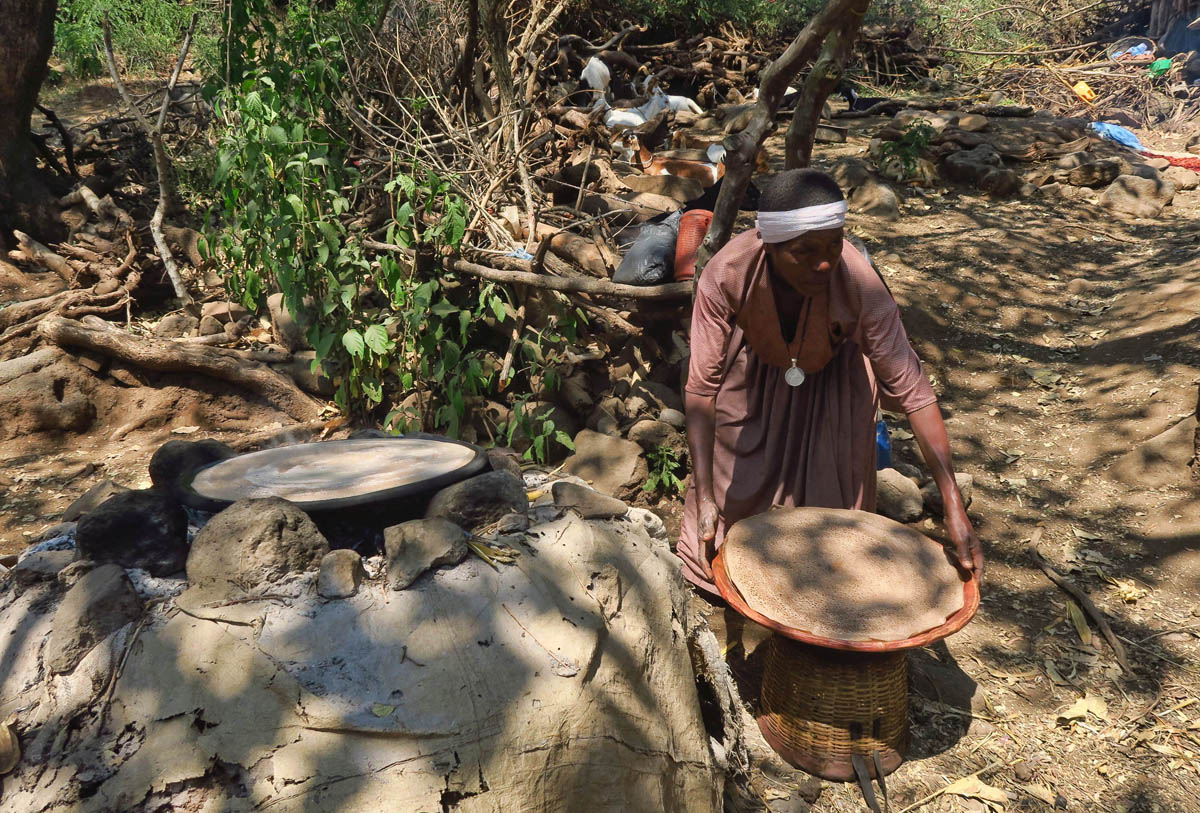
This woman is making injera, the fermented pancake used as a utensil in Ethiopian food.
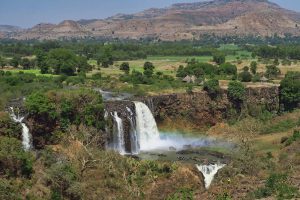
The Blue Nile Falls is one of Ethiopia’s biggest tourist attractions. Even now in low volume dry season, it is still beautiful.

The falls are known to locals as “Tis Abay” in Amharic, meaning “great smoke”.
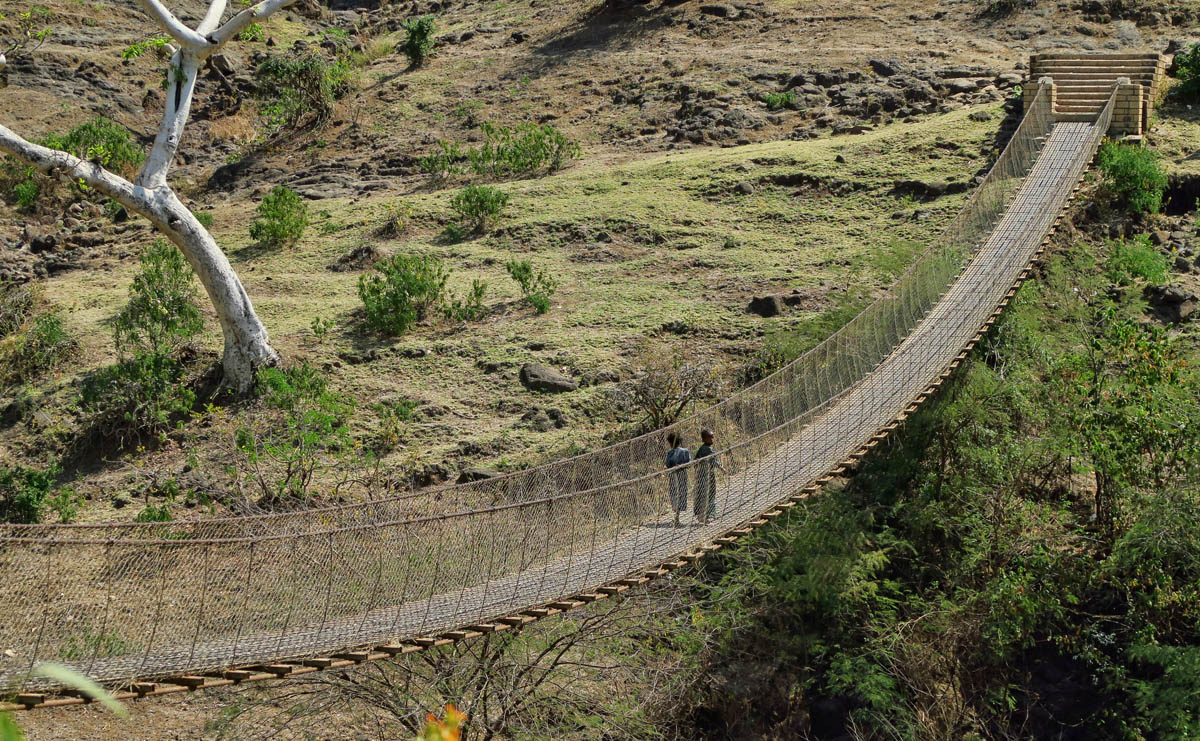
We must cross the suspension bridge (along with these two adorable young girls) to get a closer look at the falls.
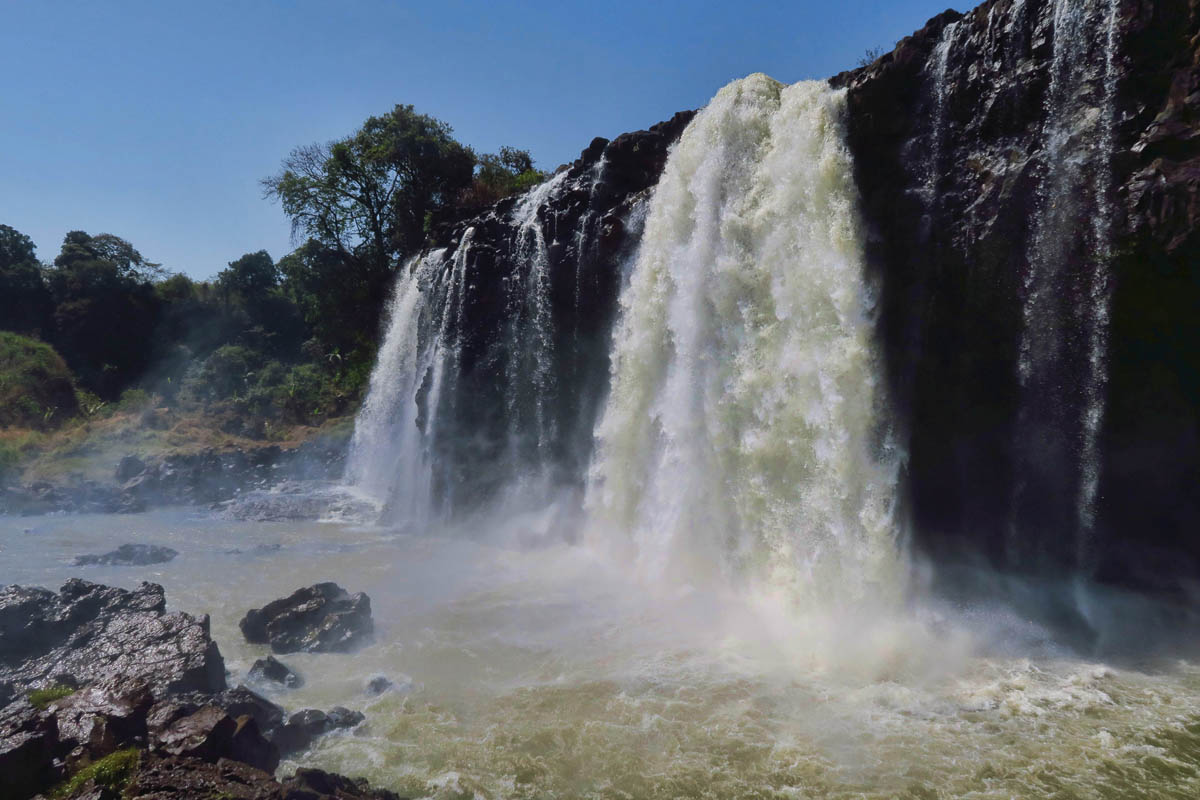
The falls are approximately 140 ft high. Best time to see the waterworks is Sept/Oct after the monsoon season.
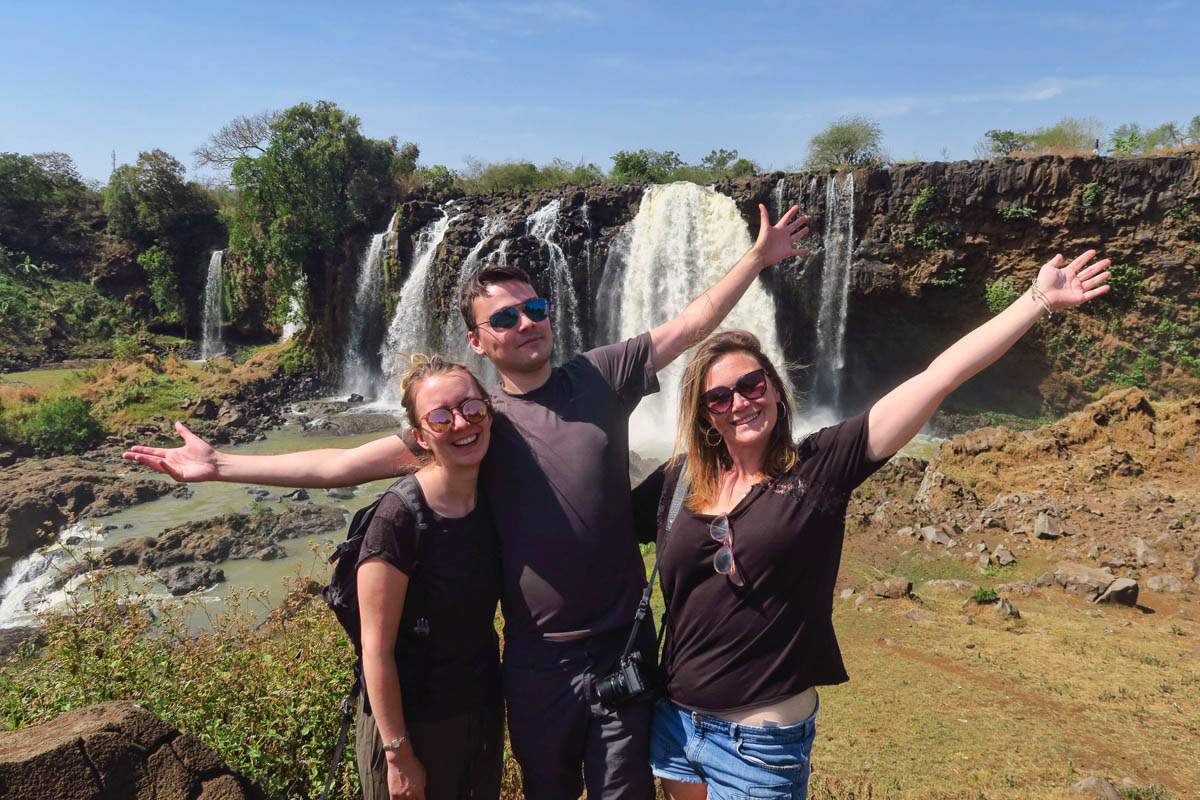
These three Millennials on the Dragoman tour adopted me as their own. We had such fun times, and the laughs continue still in our own Facebook group named for the local beer. 😉 Jasper in the center went on back to Belgium after tour ended to return to his job as an Air Traffic Controller. Sarah on the right continued on to South Africa to tour the western coast from Capetown to Nambia. She just returned to Belgium in the midst of the lock down, fashioning her Ethiopian headscarf into a face-mask for the flight home. Lynette on the left, my lovely roomie, is still in Nepal having just completed the trek to Poon Hill, and is now trying to get back to the UK. I feel sad for these two women, as they both quit their boring jobs right before the Ethiopia trip to travel. Who would have thought it would all end so abruptly…
Next Up: I say “goodbye” to my Dragoman travel-mates and face the scariest stop yet, Addis Ababa.

Such an education reading your posts! and what a great escape from all this mess! My greatest fear is that the USA, which i dearly love, wont take the continued steps it needs to in order to overcome this! Until then I look forward to each of your posts!
Since my daughter is finally “safe” at home I’m thinking of adding your blog to her now, online college education! Do you have a special subscription rate for students? or seniors? I also have AAA and Coachnet!
Totally agree Jim, that Suzanne’s posts are very educational and wonderfully thought-provoking literature too. That “solemn” community you visited Suzanne, although “absent” of any particular religion, ironically has a heavy-handed religious fervor.
Wow, Terri! What an interesting observation! I had not considered it “religious fervor,” but you are exactly right, that is what it felt like, minus the iconic symbols.
Hi, Jim. I am honored by your request, though think I would do better peddling it as a cure for insomnia! haha! I know the posts are long these days, but I had so many impressions from Ethiopia that I don’t want to forget. And unlike India where I could return over and over again, I don’t plan to pass that way again. Thanks for reading, and I am glad to hear your daughter is home.
I have to agree with your feelings towards Arwa Amba. A place where folks show no joy or even a smile no matter how shy is not a place I would want to be. I am delighted however that via your photos, words and brave trekking I’ve seen the Blue Nile Falls and beginnings. I look forward to your next post and someday seeing you on the road again! Wash your hands and stay safe 🙂
Thanks for spurring me on, Marti. Sometimes I feel like I should stop the posts for now, but then it’s about the only thing that keeps me off Twitter. 😉 You and Ed stay safe, and keep the cosmos and bourbon stocked up!
I guess a cult is a cult no matter where or seemingly ambivalent. Thanks again for sharing, the falls is beautiful and amazing for its size when you think of it in lower Egypt. Up here in new england we are beginning to enjoy the isolation of seclusion as are you. Fortunately none of ours are sick. Enjoyed your blog as always, thanks.
Allen, you and Deede please stay safe, and keep up that seclusion! Thanks for sticking with me.
Arwa Amba sounds so eerie and scary especially when you mentioned the lack of joy. What an experience. Glad all ended well. Seeing the papyrus canoe was so neat. I actual brought a papyrus replica of this boat back from Egypt. It is about a foot long and looks exactly like the one in the photo. Love the falls and that very (too) long suspension bridge. Thanks for all the new knowledge!! Stay safe and healthy!!
Thanks, Pam, and the same to you and John. I am sure it feels pretty good to have such a nice home to “shelter in place” during these times. Not a good time to be a full timer. I am fortunate to have a generous driveway host, Mom. 😉
Interesting assessment of Arwa Amba, it sound like your instincts were right. I have to hand it to you, there is no way I could take a trip like that!
Jim and Barb, I think my tolerance may be waning as well. While I really enjoyed the trip, Ethiopia is not a place on my “return to” list. Thanks for following along!
Before reading what you wrote, it struck me that all of the residents of Awra Amba that you photographed had such somber looks on their faces. Not my kind of utopia!
Your shoes looked great. How do they do such a good job cleaning them, as it doesn’t look like they have access to running water?
You would be amazed at what the Ethiopians can do with no access to running water!
I believe his success must be attributed to friction. He used a thin, damp sponge which rolled up like a cigar as he rubbed and rolled it quickly between the shoe surface and his palm. I was impressed, as I had given up hope of ever seeing their true colors again!
The before and after photo of your hiking shoes made me smile. While on a dusty trail the other day we pondered where we might be able to get our shoes cleaned for 60 cents….. ;^)